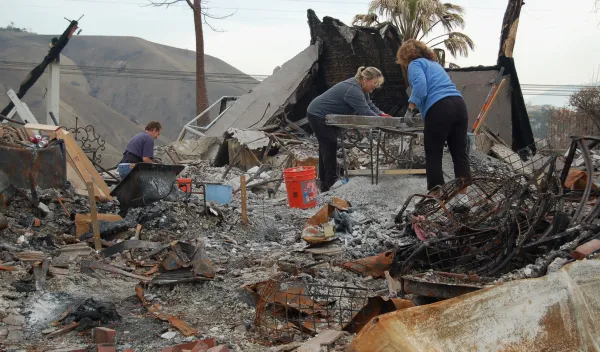
NSF and NIST collaborate on $7M disaster resilience investment
The U.S. National Science Foundation and the U.S. Department of Commerce's National Institute of Standards and Technology (NIST) have invested $7.1 million in 18 new research projects to advance community and infrastructure resilience to natural hazards. The projects are supported through the joint NSF-NIST Disaster Resilience Research Grants program, with NSF investing $3.9 million in 10 projects and NIST investing $3.2 million in eight projects.
NSF and NIST coordinate this research investment to generate new understanding, policies, designs and practices for disaster resilience.
"NSF's investment aims to reduce the disastrous economic and societal impacts of natural hazards," said Susan Margulies, NSF assistant director for Engineering. "Our partnership with NIST accelerates the novel ideas and approaches we support into planning, building codes and decision-making — strengthening our Nation's resilience to natural hazards."
Natural hazards such as earthquakes, droughts, fires, floods, hurricanes and tornadoes strike communities nationwide at significant cost to buildings, economies and people's lives. While hazard risks cannot be eliminated, technological innovations can enable communities to reduce their vulnerabilities and increase their ability to resume their lives.
"These grants support science-based methods of improving resilience, including improved planning, policy, decisions, design, codes and standards," said Joannie Chin, NIST's Engineering Laboratory director. "They can also help educate the next generation of engineers and designers and ensure that a diversity of communities is considered and given the tools they need to protect their futures."
The 10 NSF projects for disaster resilience are funded through the following awards:
- Advancing Earthquake Engineering of Cast-in-Place Concrete Diaphragms with Openings, University of Washington.
- Disinfection Resiliency and Microbial Risk in Drinking Water Distribution Systems During Extreme Heat Disasters, George Mason University.
- Enhancing Coastal Resilience through Participatory Transformation of Barrier Islands, North Carolina State University.
- Forcings, Characteristics, and Loadings of Damaging Winds in Derechos and Other High-Impact Thunderstorm Events, University of Illinois at Urbana-Champaign.
- Integrating Remote Sensing and Deep Learning for Predictive Surveillance of Mine Tailings Impoundments, University of Mississippi.
- Multimodal Disaster Impact Assessment Models for Enhanced Resilience, UCLA.
- Place-Based, Human-Centered Networks to Enhance Community Resilience and Equity, Oklahoma State University.
- Rapid, Scalable, and Joint Assessment of Seismic Multi-Hazards and Impacts: From Satellite Images to Causality-Informed Deep Bayesian Networks, Johns Hopkins University.
- Snuff It Out: Extinguishing the Disparity of Access to Shelters for Disadvantaged Communities in Wildfire-Prone Areas, George Mason University.
- Toward Equitable Power Infrastructure Resilience, Louisiana State University.
The eight NIST projects for disaster resilience, announced yesterday, are:
- Artificial intelligence-powered methods and tools to support adaptive restoration of transportation and other infrastructure after a disaster, The University of Texas at San Antonio.
- Designing for thunderstorm and downburst winds based on a web-enabled enhanced gust effects factor framework, University of Notre Dame.
- Development of a performance-based assessment model of fire resilience at the wildland-urban interface, Oklahoma State University.
- Development of an efficient and practical design method that integrates resilience and performance criteria, UC San Diego.
- Development of an open-source model for assessing the risk of infrastructure ignition due to embers or firebrands, Virginia Polytechnic Institute and State University.
- Improving predictions of the impacts of storm wave- or current-carried debris on elevated structures, University of Notre Dame.
- Methods, modeling and roadmaps to support the security and resiliency of electrical power infrastructure in coastal regions and islands, State University of New York at Albany.
- Understanding risks to acute care access and flood impacts to improve disaster preparedness and help ensure continuity of care, University of Delaware.
The Disaster Resilience Research Grant (DRRG) program is part of NSF's broader coordination of its disaster-related research portfolio with NIST and other federal agencies for the National Earthquake Hazards Reduction Program (NEHRP) and the National Windstorm Impact Reduction Program (NWIRP). For both NEHRP and NWIRP, NSF is responsible for advancing fundamental understanding and NIST is responsible for ensuring that fundamental new insights are translated to practice, as well as for conducting applied research.
The NSF awards are funded through the DRRG program in the Division of Civil, Mechanical and Manufacturing Innovation in the NSF Directorate for Engineering, with additional support from the Division of Chemical, Bioengineering, Environmental and Transport Systems.
Learn about previous investments in the program and NSF activities for disaster risk and resilience.
